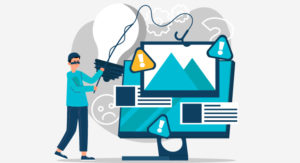What is Third Party Risk Management?

Third-party risk management (TPRM) is a type of risk management program that focuses on identifying and reducing risks that come with the use of third parties. Third parties that open businesses to risk are vendors, suppliers, partners, contractors, or service providers.
The risk management program aims to give organizations an understanding of the third parties they use. TPR programs are dependent on the type of organizations, the industry they operate in, and several other factors. But, several TPRM practices are universal and applicable to every business.
Third-party risk management often encompasses all the practices that help businesses prevent third-party risks and fraud.
In this guide, we’ll go over what is third-party risk management and common TPRM practices businesses can use.
Importance of Third-Party Risk Management
Third-party risk management has been around for a long time. However, l with recent growth in third-party fraud cases has increased the need for third-party risk management.
Disruptive events have impacted thousands of businesses globally. Moreover, several data breaches have been directly related to poor third-party risk management.
Some of the most common ways businesses can be impacted are:
- Internal outages and slowing down operational capabilities.
- External outages affect areas such as the supply chain.
- Vendor risks that make your business vulnerable to supply chain fraud.
- Operational shifts that affect data gathering, storage, and security.
Almost all organizations today use some kind of third-party provider to keep their operations running smoothly. So, when there’s an issue with your third-party suppliers, your business suffers greatly.
Let’s say you’re using a cloud platform such as Amazon Web Services (AWS) to host your website. If AWS goes down for a couple of hours, your operations also go down.
Outsourcing is crucial for the success of modern businesses, it not only saves businesses money, but it also helps in getting help from experts.
Unfortunately, there’s a downside. If proper third-party risk management programs aren’t in place, the use of third parties can leave your business open to several risks.
Best Third-Party Risk Management Practices
Businesses can use several third-party practices that help you build a better program, regardless of where your business currently stands. Here are the 3 best practices that apply to almost every company.
1. Prioritize Your Inventory
Not all vendors are equally important for your business, this is why you need to determine which third-party vendors matter the most. To improve the efficiency of your third-party risk management program, you need to segment your vendors.
You can segment the vendors into 3 categories:
- Low risk, low criticality – Tier 3
- Medium risk, medium criticality – Tier 2
- High risk, high criticality – Tier 1
Generally, organizations will focus their time and resources on tier 1 vendors first, as they require more stringent due diligence and evidence collection. Tier 1 vendors are subject to the most in-depth assessments, which often include on-site assessments.
A lot of times, during the initial evaluation, these tiers are calculated based on the inherent risk of a third party. Inherent risk scores are generated based on industry benchmarks. These include:
- Sharing proprietary or confidential business information with the vendor
- Sharing personal data with the vendor
- Serving critical business functions
- Sharing sensitive personal data with the vendor
- Sharing personal data across borders
The impact of a vendor can also be a determining factor. Let’s say a third-party vendor is unable to deliver their service, how much impact will that have on your business? When there is significant disruption in your operations, the vendor will also be higher. Businesses can figure out the impact by considering these factors:
- The impact of unauthorized disclosure of information
- Impact of unauthorized modification or destruction of information
- Impact of disruption of access to the vendor/information
Another way to determine the impact of a vendor’s inability to deliver their work is by grouping based on contract value. Vendors that have huge budgets may automatically be segmented as tier-1.
2. Leverage Automation Whenever Possible
Efficiencies only happen when operations are consistent and repeatable. There are several areas in the third-party risk management process where businesses need automation. Some areas where businesses can use automation include:
- Intaking and onboarding new vendors
Businesses can add vendors to their inventory by using an intake form or via integration with contract management or other systems.
Solutions like DIRO online document verification can help businesses in verifying vendor identity during onboarding. This helps in reducing vendor risk significantly.
- Calculating inherent risk and tiering vendors
During the vendor onboarding process, businesses need to collect vendor information that helps in calculating the level of risk the vendor poses for the business.
Based on the level of risk, businesses can set up different levels of due diligence for vendors. This helps prevent fraud that comes with poor third-party risk management.
- Assigning risk owners and mitigation tasks
Whenever a vendor is flagged, route the risk to the correct individual and include a checklist of mitigation action items.
- Triggering vendor performance reviews
You need to set up automation tiggers that conduct reviews of vendors during specific times of the year. The reviews could be each quarter, every 6 months, or once a month.
- Triggering vendor reassessment
Businesses should send an assessment based on contract expiration dates. Businesses should also save last year’s assessment answers so vendors don’t have to start completely from scratch.
- Scheduling and running reports
Businesses should set up automated reports that run every day, every week, or every month. These reports must be shared with the right person.
Every third-party risk management program is unique, so as a business, you need to start by looking internally at the small processes that can be automated.
3. Think beyond cybersecurity risks
Whenever businesses think of third-party risk management or vendor risk management programs, they think of cybersecurity risks. But, third-party vendor management is far more than cybersecurity risks.
While it is important to focus on small things and consider cybersecurity risks, there are other types of risks that businesses should prioritize, such as:
- Reputational risks
- Geographical risks
- Geopolitical risks
- Strategic risks
- Financial risks
- Operational risks
- Privacy risks
- Compliance risks
- Ethical risks
- Business continuity risks
- Performance risks
- 4th party risks
- Credit risks
- Environmental risks
How Can DIRO Help?
DIRO online document verification solution can help businesses strengthen their third-party risk management practices. Third-party fraud risks start from the moment a business onboards a vendor without proper verification.
DIRO online document verification solution helps businesses verify crucial vendor information that can help in fraud prevention in the long run. DIRO can verify these documents:
- Proof of address
- Bank statements
- Vendor documents
- Utility bills
- Incorporation documents and more.
Learn more about how DIRO can enhance your third-party risk management program by requesting a demo today.












